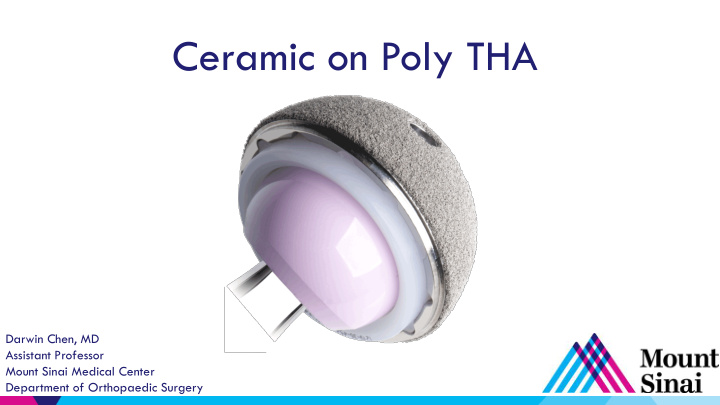



Ceramic on Poly THA Darwin Chen, MD Assistant Professor Mount Sinai Medical Center Department of Orthopaedic Surgery
Disclosures ▶ Monogram Orthopedics Consultant –
Why Bother With Anything But Ceramic on Poly THA? Ceramic liner fx Metal-metal failure Taper corrosion – M on P Dual mobility disassociation Darwin Chen, MD Assistant Professor Mount Sinai Medical Center Department of Orthopaedic Surgery
Trends in Total Hip Arthroplasty ▶ The fundamentals have not changed! ▶ Major challenge – implant longevity – Patients living longer • 1/3 of ♀ age 50 will live to be 100 – Expanding THA indications Sir John Charnley at his lathe, creating the • Younger, more active first THA implants • Higher functional demands/expectations
Goals of the Bearing Articulation ▶ Minimize wear/biologically active debris ▶ Maximize hip stability ▶ Avoid bearing related complications Pre op Santoro, J
Which Bearing Should I Use for My Patient? ▶ Age? ▶ Activity level? – Metal on poly – Ceramic on poly – Ceramic on ceramic – Metal on metal – Ceramic on metal Bedard, Callaghan, JoA 2017
Osteolysis Directly Correlates With Wear Dumbelton JH, JoA 2002 ▶ “Threshold” for osteolysis is <0.1mm/yr (~650mm 3 ) Wilkinson JR, JOR 2005 Dowd, JBJS 2000 Looney RJ 2002
Larger Heads = Better Stability Berry, 2005
Larger Heads = Better Stability Howie, 2012 At one year following surgery: 28mm 36mm Primary 4.4% 0.8% Revision 12.2% 4.9% Overall 5.4% 1.3%
Larger Heads = Better Stability Garbuz, 2012
How is Metal on XLPE Doing? ▶ Pretty well! Feb 2013 – CoCr on XLPE, 7-10yr f/u – 28mm wear rate 0.012mm/yr – 32mm wear rate 0.01mm/yr – No osteolysis
How is Metal on XLPE Doing? ▶ Pretty well! Sept 2016 – CoCr on Longevity XLPE, 28mm and 36mm – Mean wear @ 13 yrs = 0.05mm/yr – No difference between sizes – No osteolysis
Taper Corrosion Cooper, 2012 ▶ Corrosion of CoCr head on Ti stem, ↑ Co/Cr ions ▶ An “emerging” problem with M on P ▶ Multifactorial Taper geometry, metallurgy, head size, assembly technique – ▶ Can cause mild to severe ALTR Late instability, abductor damage, osteolysis –
Taper Corrosion ▶ Ceramic head significantly reduces potential for taper corrosion Significantly greater metal release (11x increase in Co and 3x increase in Cr) from a CoCr / CoCr interface – when compared to a Co-Cr / ceramic interface Corrosion can still occur – Cooper, JBJS(Am) 2013) ▶ When used with a titanium stem, no source of Co and Cr debris that can lead to ALTR
Delta Ceramic ▶ Matrix composite ceramic ▶ Zirconia toughened, platelet reinforced, alumnia ceramic ▶ 82% alumina, 17% zirconia, 0.5% strontium aluminate, 0.5% chromium oxide
Ceramic on Poly ▶ Avoid issues with hard-hard bearings ▶ Properties of ceramics further reduce wear characteristics of XLPE ▶ Delta ceramics – 50% stronger than alumina – More abrasion resistant than CoCr – 3x hardness of CoCr – Wettable – Biocompatible
Wear Rate - Ceramic on Poly ▶ Simulator data shows clear advantage of C-on-P over M-on-P , 40-50% reduction Fisher, 2006 Galvin, Proc Inst Mech Eng 2010 Kim, 2005 CoCr Ceramic Total Linear Wear 1.21 mm 0.57mm p = 0.004 Linear Wear Rate 0.17 mm/yr 0.08 mm/yr p = 0.004 Volumetric Wear 744.7 mm 3 350.8 mm 3 p = 0.004
Comparison Testing Bradgon 2006, Greenwald 2006, Manning 2005, Martell 2003, Zichner 1992,1997
Ceramic Head Fracture ▶ Historically, ceramic head fracture was a significant clinical concern – Old aluminas were low density, coarse microstructure, not in compliance with today’s specifications ▶ Current alumnia and Delta ceramic substantially improved mechanical strength ▶ Biolox ceramic head fx rate 1 st gen Alumina – 0.026% – 0.014% 2 nd gen Alumina – 0.004% Delta Willmann, Clin Orthop 2000
Ceramic Head Fracture ▶ Delta head fractures are negligible with 32/36 heads
Ceramics – Less Risk of PJI? ▶ In theory, ceramics have less bacterial biofilm formation due to decreased surface roughness and molecular composition ▶ Reduced wear = reduced bio-burden of PE particles, less inflammation ▶ No Co, Cr ion release – no immune suppression? Ceramtec, Inc.
Ceramics – Less Risk of PJI? March 2017 ▶ Medicare database (315,784 patients) ▶ C-P and C-C exhibit lower risk of infection comparted to M-P (C-P hazard ratio 0.86, p=0.001. C-C hazard ratio 0.74, p=0.01) ▶ C-P reduced risk of dislocation and mortality (HR 0.81, p<0.001, HR 0.92. p<0.001)
Conclusions ▶ In 2018, ceramic on poly is the best choice for most THAs ▶ Excellent wear properties ▶ Eliminates the metal ion problem ▶ No squeaks, negligible fracture risk ▶ Reduced PJI? ▶ Forgiving, no change in technique
Thank You Darwin Chen, MD Assistant Professor Mount Sinai Medical Center Department of Orthopaedic Surgery
Recommend
More recommend